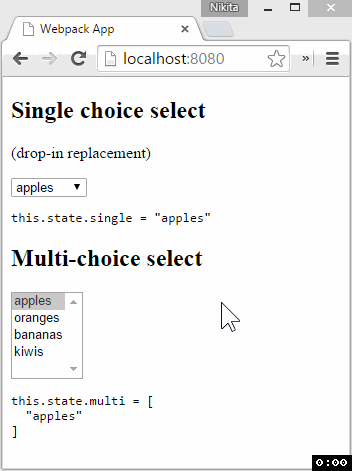Normalized <select>, returns array of values in multiple mode
When using common <select> element it returns only single value in onChange event. So to get the array of selected values it is necessary to traverse through it's options to find selected ones. This component normalizes behaviour of <select> so it returns array of values if multiple={true} flag is present.
Component is a pure wrapper, has no extra logic and supposed to be a drop-in replacement for a conventional <select>
This normalization is necessary to work in composition with other form elements wrappers without breaking onChange API.
npm install --save react react-normalized-selectDon't forget to manually install peer dependencies (react) if you use npm@3.
bower install --save https://npmcdn.com/react-normalized-select/bower.zip<script src="https://npmcdn.com/react/dist/react.js"></script>
<script src="https://npmcdn.com/react-normalized-select/build/react-normalized-select.js"></script>
(Module exposed as `NormalizedSelect`)http://nkbt.github.io/react-normalized-select
// TODOAll functionality is the same as for <select>.
import Select from 'react-normalized-select';
// ...
<Select className="mySelect" onChange={e => console.log(e.target.value)}>
{['apples', 'oranges', 'bananas'].map(option =>
<option key={option} value={option}>{option}</option>)}
</Select>Will render conventional <select> and by choosing apples we will get apples in a console
Will return array of selected values instead of single string value.
import Select from 'react-normalized-select';
// ...
<Select className="mySelect" multiple={true} onChange={e => console.log(e.target.value)}>
{['apples', 'oranges', 'bananas'].map(option =>
<option key={option} value={option}>{option}</option>)}
</Select>Will render conventional <select> but when we choose apples and bananas, we will get [apples, bananas] in a console
import React from 'react';
import ReactDOM from 'react-dom';
import Select from 'react-normalized-select';
const App = React.createClass({
getInitialState() {
return {
single: 'apples',
multi: ['apples']
};
},
renderOptions() {
return ['apples', 'oranges', 'bananas', 'kiwis']
.map(option => <option key={option} value={option}>{option}</option>);
},
render() {
return (
<div>
<div>
<h2>Single choice select</h2>
<p>(drop-in replacement)</p>
<label>
<Select
value={this.state.single}
onChange={e => this.setState({single: e.target.value})}>
{this.renderOptions()}
</Select>
</label>
<pre>this.state.single = {JSON.stringify(this.state.single, null, ' ')}</pre>
</div>
<div>
<h2>Multi-choice select</h2>
<label>
<Select multiple={true}
size={5}
value={this.state.multi}
onChange={e => this.setState({multi: e.target.value})}>
{this.renderOptions()}
</Select>
</label>
<pre>this.state.multi = {JSON.stringify(this.state.multi, null, ' ')}</pre>
</div>
</div>
);
}
});
const appRoot = document.createElement('div');
document.body.appendChild(appRoot);
ReactDOM.render(<App />, appRoot);Currently is being developed and tested with the latest stable Node 6 on OSX and Windows.
To run example covering all NormalizedSelect features, use npm start dev, which will compile src/example/Example.js
git clone git@github.com:nkbt/react-normalized-select.git
cd react-normalized-select
npm install
npm start dev
# then
open http://localhost:8080# to run tests
npm start test
# to generate test coverage (./reports/coverage)
npm start test.cov
# to run end-to-end tests
npm start test.e2eMIT







